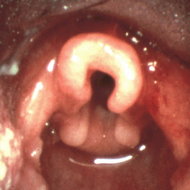INTRODUCTION: A forty-four year old woman was referred for refractory asthma characterized by fifteen years of variable dyspnea, worse on exertion and associated with audible wheezing. She had-responded poorly to inhaled and oral glucocorticoids. Flexible rhinolaryngoscopy showed collapse of the arytenoids during sniff maneuver resulting in supraglottic airway obstruction. A diagnosis of laryngomalacia was made. The otorhinolaryngologists recommended resection of redundant aryepiglottic folds and cuneiform cartilages but the patient refused the procedure.
CASE PRESENTATION: A 44 year-old white woman presented for evaluation of uncontrolled asthma with persistent dyspnea on exertion and wheezing. Her current treatment regimen included Advair 500/50 BID, Combivent four puffs QID, DuoNeb QID, Singulair 10 mg daily and prednisone 20-60 mg as directed. Despite this aggressive medication protocol she continued to experience frequent symptoms and had developed medically complicated obesity related to prednisone use. She suffered from frequent attacks of dyspnea requiring multiple emergency room evaluations and unscheduled urgent clinic visits consulting her local allergists and pulmonologists. She was referred to our institution with "refractory asthma." Clinically, she described an unpredictable pattern of symptoms consisting of the abrupt onset of dyspnea associated with air hunger and a sensation of chest/throat tightness during activity. Pulmonary function tests (PFTs) showed mild restrictive lung disease without obstruction. Her vital signs were normal. Her BMI measured 56. Auscultation of the chest revealed upper airway wheeze. Initial ear, nose, throat and neck exam was unremarkable. Flexible fiberoptic rhinolaryngoscopy was performed to evaluate for chronic rhinosinusitis or vocal cord dysfunction. The nasal passages showed purulent secretions from the right maxillary sinus os. The scope was advanced into the oropharynx. The laryngeal complex was evaluated for laryngopharyngeal reflux, growths, and vocal cord mobility. When the patient was asked to perform the sniff maneuver, the arytenoids and both proximal aryepiglottic folds collapsed medially covering the laryngeal opening and inducing dramatic airway obstruction. This is seen at real time speed and at half speed (sees images). Due to tongue traction supporting the arytenoids at the time of rigid laryngoscopy, the otolaryngologists initially tailed to observe this obstructing phenomenon. The collapse of the arytenoids and medialization of the aryepiglottic folds and cuneiform cartilages with resultant airway obstruction and audible wheezing was easily demonstrated with the flexible fiberoptic rhinolaryngoscope.
DISCUSSIONS: This is an unusual presentation of laryngomalacia as a cause of steroid refractory asthma and is different from vocal cord dysfunction. Her lack of response to conventional asthma treatments and the unpredictable pattern of dyspnea were a result of a functional and anatomical abnormality. Laryngeal obstruction due to medialization of the aryepiglottic folds and cuneiform cartilages resulting in strider and air hunger during sniff maneuver is an unusual cause of upper airway obstruction masquerading as steroid refractory asthma. Recommendations included tapering of oral prednisone, weight reduction, speech therapy and reassessment for possible resection of the occluding supraglottic structures. The patient refused to consider the surgical option.
CONCLUSION: There are many symptoms and patient complaints that may be mistaken for bronchospasm and asthma. A variety of upper and lower airway obstructive processes may produce audible inspiratory or expiratory breath sounds. It is important to take an accurate history, complete appropriate diagnostic studies and interpret those studies correctly. Here we demonstrate the utility of routine office based flexible rhinolaryngoscopy in pulmonary practice for evaluating patients with refractory dyspnea and typical symptoms of asthma.
DISCLOSURE: Michael Pietila, None.
[ILLUSTRATIONS OMITTED]
Michael P. Pietila MD * Timothy I. Morgenthaler MD Udaya B. Prakash MD Kaiser G. Lim MD Mayo Clinic, Rochester, MN
COPYRIGHT 2005 American College of Chest Physicians
COPYRIGHT 2005 Gale Group



